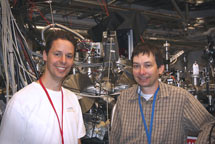
Handy Links
SLAC News Center
SLAC Today
- Subscribe
- Archives: Feb 2006-May 20, 2011
- Archives: May 23, 2011 and later
- Submit Feedback or Story Ideas
- About SLAC Today
SLAC News
Lab News
- Interactions
- Lightsources.org
- ILC NewsLine
- Int'l Science Grid This Week
- Fermilab Today
- Berkeley Lab News
- @brookhaven TODAY
- DOE Pulse
- CERN Courier
- DESY inForm
- US / LHC
SLAC Links
- Emergency
- Safety
- Policy Repository
- Site Entry Form

- Site Maps
- M & O Review
- Computing Status & Calendar
- SLAC Colloquium
- SLACspeak
- SLACspace
- SLAC Logo
- Café Menu
- Flea Market
- Web E-mail
- Marguerite Shuttle
- Discount Commuter Passes
-
Award Reporting Form
- SPIRES
- SciDoc
- Activity Groups
- Library
Stanford
Around the Bay
Second LCLS User Run Begins Today
Linac Coherent Light Source users are on-site and the X-ray beam is knocking at the door of the Near Experimental Hall in preparation for the second LCLS user run, which begins this morning at 9:00 a.m. and will continue through September 2010.
"This is an exciting time," said LCLS Deputy Director Uwe Bergmann. "We're commissioning new instruments, moving to even more advanced experiments and expanding the imaging capabilities."
Between October and December 2009, researchers from around the globe traveled to SLAC to get the first glimpses into how the LCLS X-ray beam interacts with atoms and molecules. This first user run focused on proof-of-principle experiments and first imaging studies in the Atomic, Molecular and Optical physics hutch.
The second user run will add more advanced experiments in the AMO hutch and, after extensive commissioning, will also include the first experiments with the Soft X-Ray Materials Science beamline. Commissioning on a third instrument, the X-ray Pump Probe, will begin midway through this run.
The first experiment of the run is led by Jochen Küpper, who heads a group at the Max Planck Society's Fritz Haber Institute that focuses on manipulating the motion of molecules. Over the next week, Küpper and colleagues will work with AMO Instrument Scientists Christoph Bostedt and John Bozek to probe molecules made up of two iodine atoms separated by a benzene ring. Using the CAMP chamber, the researchers will attempt to image the structure of these molecules down to the distances between atoms.
"We're going to see if, when you really whack a molecule hard with a free-electron laser, you can see structure on this interatomic level before the whole thing vaporizes," said collaborator Henry Chapman, who is a founding director of the newly established Center for Free-Electron Laser Science, an enterprise of the German laboratory DESY, the Max Planck Society and the University of Hamburg.
Over the next five months, researchers will also use the LCLS beam to study biological samples, correlated materials and the ultrafast chemical reactions that take place on a material's surface, to name just a few areas of exploration.
In addition to more advanced experiments, this run will also include a new schedule. During the first run, users took data 24 hours a day for as many as five days at a time. This time around, because two different hutches will operate simultaneously, two sets of users will conduct experiments in 12-hour stretches, with one group taking data from 9 a.m. to 9 p.m. and the other from 9 p.m. to 9 a.m., five days a week. The remaining two days will be used to conduct any work needed on the accelerator and the instruments.
"We hope this is a more efficient way to run, giving users time to prepare and troubleshoot in one hutch while others get beam in another hutch," Bergmann said. "Researchers can use the 12-hour downtimes to look at their data, make instrument adjustments, and get some sleep while another group is taking data."
Overall, users will conduct 23 experiments in the second run. These experiments were chosen from 62 submitted proposals involving 469 scientists from 15 countries.
—Kelen Tuttle
SLAC Today, May 6, 2010
